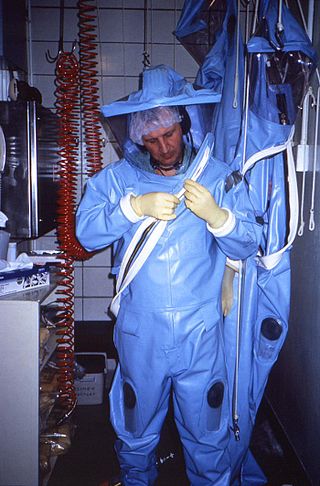
Biosafety is the prevention of large-scale loss of biological integrity, focusing both on ecology and human health. These prevention mechanisms include the conduction of regular reviews of biosafety in laboratory settings, as well as strict guidelines to follow. Biosafety is used to protect from harmful incidents. Many laboratories handling biohazards employ an ongoing risk management assessment and enforcement process for biosafety. Failures to follow such protocols can lead to increased risk of exposure to biohazards or pathogens. Human error and poor technique contribute to unnecessary exposure and compromise the best safeguards set into place for protection.
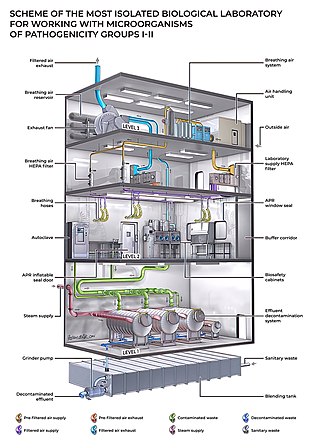
A biosafety level (BSL), or pathogen/protection level, is a set of biocontainment precautions required to isolate dangerous biological agents in an enclosed laboratory facility. The levels of containment range from the lowest biosafety level 1 (BSL-1) to the highest at level 4 (BSL-4). In the United States, the Centers for Disease Control and Prevention (CDC) have specified these levels in a publication referred to as BMBL. In the European Union, the same biosafety levels are defined in a directive. In Canada the four levels are known as Containment Levels. Facilities with these designations are also sometimes given as P1 through P4, as in the term P3 laboratory.

A biological hazard, or biohazard, is a biological substance that poses a threat to the health of living organisms, primarily humans. This could include a sample of a microorganism, virus or toxin that can adversely affect human health. A biohazard could also be a substance harmful to other living beings.

Cleaning is the process of removing unwanted substances, such as dirt, infectious agents, and other impurities, from an object or environment. Cleaning is often performed for aesthetic, hygienic, functional, safety, or environmental protection purposes. Cleaning occurs in many different contexts, and uses many different methods. Several occupations are devoted to cleaning.
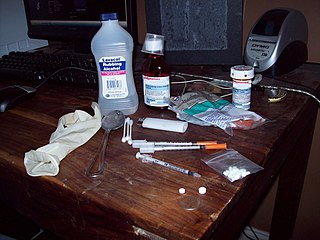
A blood-borne disease is a disease that can be spread through contamination by blood and other body fluids. Blood can contain pathogens of various types, chief among which are microorganisms, like bacteria and parasites, and non-living infectious agents such as viruses. Three blood-borne pathogens in particular, all viruses, are cited as of primary concern to health workers by the CDC-NIOSH: HIV, hepatitis B (HVB), & hepatitis C (HVC).

Environmental remediation is the cleanup of hazardous substances dealing with the removal, treatment and containment of pollution or contaminants from environmental media such as soil, groundwater, sediment. Remediation may be required by regulations before development of land revitalization projects. Developers who agree to voluntary cleanup may be offered incentives under state or municipal programs like New York State's Brownfield Cleanup Program. If remediation is done by removal the waste materials are simply transported off-site for disposal at another location. The waste material can also be contained by physical barriers like slurry walls. The use of slurry walls is well-established in the construction industry. The application of (low) pressure grouting, used to mitigate soil liquefaction risks in San Francisco and other earthquake zones, has achieved mixed results in field tests to create barriers, and site-specific results depend upon many variable conditions that can greatly impact outcomes.

A needlestick injury is the penetration of the skin by a hypodermic needle or other sharp object that has been in contact with blood, tissue or other body fluids before the exposure. Even though the acute physiological effects of a needlestick injury are generally negligible, these injuries can lead to transmission of blood-borne diseases, placing those exposed at increased risk of infection from disease-causing pathogens, such as the hepatitis B virus (HBV), hepatitis C virus (HCV), and human immunodeficiency virus (HIV). Among healthcare workers and laboratory personnel worldwide, more than 25 blood-borne virus infections have been reported to have been caused by needlestick injuries. In addition to needlestick injuries, transmission of these viruses can also occur as a result of contamination of the mucous membranes, such as those of the eyes, with blood or body fluids, but needlestick injuries make up more than 80% of all percutaneous exposure incidents in the United States. Various other occupations are also at increased risk of needlestick injury, including law enforcement, laborers, tattoo artists, food preparers, and agricultural workers.
Infection prevention and control is the discipline concerned with preventing healthcare-associated infections; a practical rather than academic sub-discipline of epidemiology. In Northern Europe, infection prevention and control is expanded from healthcare into a component in public health, known as "infection protection". It is an essential part of the infrastructure of health care. Infection control and hospital epidemiology are akin to public health practice, practiced within the confines of a particular health-care delivery system rather than directed at society as a whole.

The Illinois Environmental Protection Agency of the state of Illinois is the primary body concerned with the protection of the environment for the state. The Illinois EPA's mission is "to safeguard environmental quality, consistent with the social and economic needs of the State, so as to protect health, welfare, property and the quality of life."
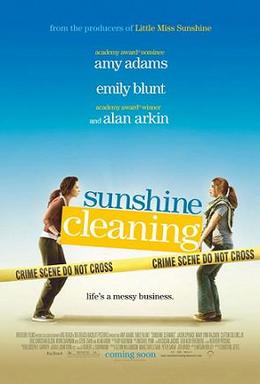
Sunshine Cleaning is a 2008 American comedy-drama film written by Megan Holley and directed by Christine Jeffs. It stars Amy Adams, Emily Blunt, and Alan Arkin. The story revolves around two sisters who start a crime scene cleanup business and the various events that occur in their respective lives. Produced by Big Beach, the film premiered at the Sundance Film Festival on January 18, 2008, and was given a limited theatrical release in the United States on March 13, 2009, by Overture Films. Sunshine Cleaning garnered positive reviews from critics and was a minor box-office hit, grossing $17.3 million against a $5 million budget. The film was released on DVD and Blu-ray on August 25, 2009.
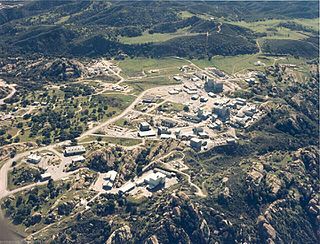
The Energy Technology Engineering Center (ETEC), was a government-owned, contractor-operated complex of industrial facilities located within the 2,850-acre (11.5 km2) Santa Susana Field Laboratory (SSFL), Ventura County, California. The ETEC specialized in non-nuclear testing of components which were designed to transfer heat from a nuclear reactor using liquid metals instead of water or gas. The center operated from 1966 to 1998. The ETEC site has been closed and is now undergoing building removal and environmental remediation by the U.S. Department of Energy.
Aftermath Services, a ServiceMaster company, performs crime scene clean up, homicide cleanup, suicide cleanup, hoarding cleanup, unattended death cleanup, infectious disease disinfection, and other trauma cleanup and specialty biohazard cleaning services such as hoarding and tear gas cleanup. Headquartered in Aurora, IL, the company has been in business since 1996 and maintains locations serving 48 of the United States. The company pioneered its field and was the subject of a book by the same name. The company manufactures proprietary cleaning agents engineered specifically for cleaning biomatter and bodily fluids.
Brownfields are defined by the Environmental Protection Agency (EPA) as properties that are complicated by the potential presence of pollutants or otherwise hazardous substances. The pollutants such as heavy metals, polychlorinated biphenyls (PCB), poly- and per-fluoroalkyl substances (PFAS), and volatile organic compounds (VOCs) contaminating these sites are typically due to commercial or industrial work that was previously done on the land. This includes locations such as abandoned gas stations, laundromats, factories, and mills. By a process called land revitalization, these once polluted sites can be remediated into locations that can be utilized by the public.

Advanced Bio-Treatment (ABT) is a biohazard response and remediation company operating in twenty-eight states. The company employs a multitude of cleanup teams specializing in crime scene cleanup. Day-to-day business operations are overseen by a customer service driven team from the company’s corporate office located in Jacksonville, Florida.
Operations Plus WMD is a training level in dealing with hazardous materials.

Between 1947 and 1977, General Electric polluted the Hudson River by discharging polychlorinated biphenyls (PCBs) causing a range of harmful effects to wildlife and people who eat fish from the river. Other kinds of pollution, including mercury contamination and cities discharging untreated sewage, have also caused problems in the river.

Bio Recovery is an American company that handles crime scene and bio-hazard cleanups. The company assisted in the clean-up of the apartment of Craig Spencer, who worked with Doctors Without Borders, when he contracted Ebola, as well as a bowling alley he visited in New York.
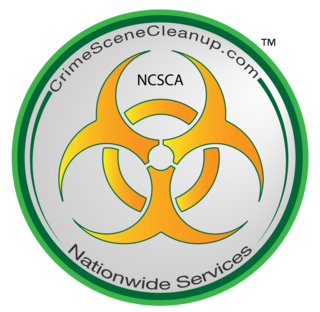
The National Crime Scene Cleanup Association is an American company, owned by Prestige Worldwide Ind Corp., that provides crime scene cleanup, hoarding cleanup training, trauma cleanup training, unattended death cleanup training, as well as various types of remediation service training, such as mold, tear gas, or methamphetamine laboratories. Their crime scene cleaners are licensed professionals. National Crime Scene Cleanup Association is headquartered out of Patchogue, NY, as well as holding various satellite offices throughout the continental United States.

Hazard controls for COVID-19 in workplaces are the application of occupational safety and health methodologies for hazard controls to the prevention of COVID-19. Vaccination is the most effective way to protect against severe illness or death from COVID-19. Multiple layers of controls are recommended, including measures such as remote work and flextime, increased ventilation, personal protective equipment (PPE) and face coverings, social distancing, and enhanced cleaning programs.
The Global Biorisk Advisory Council® (GAC), a Division of ISSA, is a network of international leaders in the field of microbial-pathogenic threat analysis, mitigation and response and recovery. GAC provides services intended to assist individuals, institutions, companies and governments in assessing preparedness. It also offers education and training to respond and recover in critical biohazardous events, with an emphasis on microbial containment and psychological surety.














